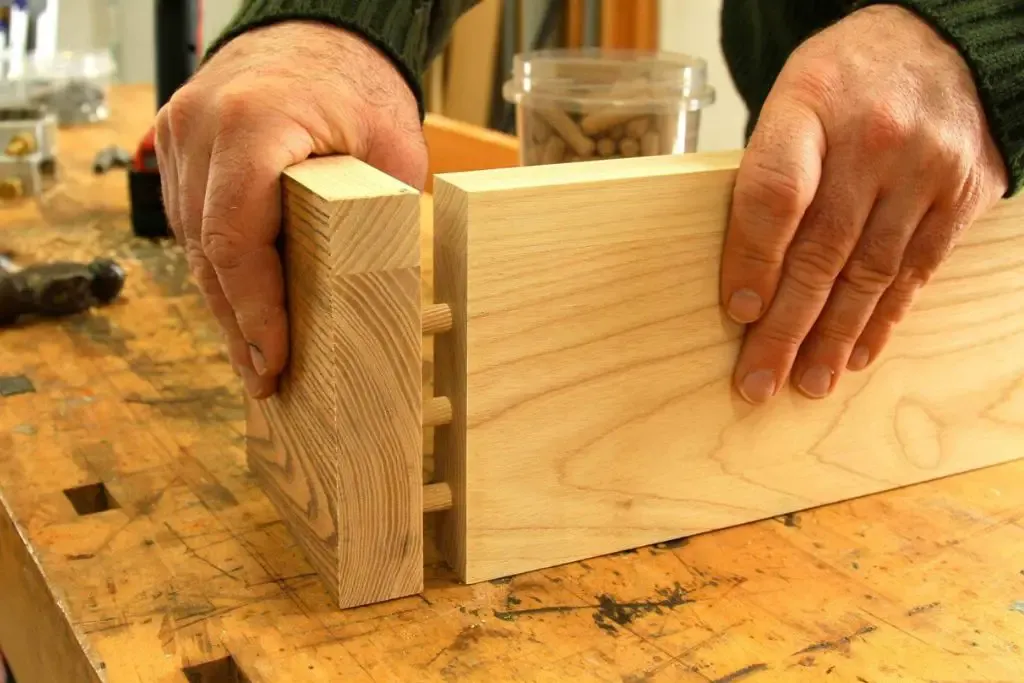
Woodworking, much like a fine wine, matures beautifully over time. The rhythmic sound of the saw, the aroma of fresh-cut wood, and the satisfaction of creating something with one’s own hands have drawn people to this craft for centuries.
From the ancient civilizations that built majestic wooden structures to the modern-day artisans crafting intricate design.
Woodworking has been an integral part of human history, reports Ancient Origins.
As the years have rolled by, we’ve witnessed the craft flourish with remarkable advancements.
From the humble beginnings of using stones and bones to the sophisticated tools of today, woodworking has truly come a long way.
The evolution of techniques, combined with technological advancements, has transformed the way we approach this age-old craft.
While many of us still cherish the timeless classics like dovetails and mortise-and-tenon, the contemporary woodworking scene has ushered in some truly ingenious joinery methods.
These methods not only make the process more efficient but also enhance the durability and aesthetics of the finished product.
The fusion of tradition with innovation has led to the development of techniques that are both functional and visually appealing.
Whether you’re a seasoned craftsman, an enthusiast, or a newbie with a budding passion, let’s dive deep into the modern marvels of woodworking joinery. Put your woodworking aprons on and let’s get joining.
Table of Contents
Biscuit Joinery

Biscuit joinery is a woodworking technique where crescent-shaped slots are cut into two pieces of wood and joined together using a wooden “biscuit” and glue.
Essential Tools:
- Biscuit joiner
- Biscuits
- Your reliable wood glue
Steps to Master:
- Begin by marking the spots where the wood pieces should unite.
- Ready your biscuit joiner and carve out those unique crescent slots.
- Generously apply wood glue within these slots and introduce the biscuit.
- Securely clamp the pieces until the glue firmly bonds them.
Why It’s a Game-Changer
Biscuit joinery is woodworking’s best-kept secret. Though concealed, it’s incredibly effective, especially when crafting tabletops.
It ensures a seamless connection, making it a favorite among those who prioritize aesthetics.
This method has gained popularity in recent years due to its efficiency and the clean finish it provides.
Pocket-Hole Joinery

Pocket-hole joinery is a method where angled holes are drilled into one piece of wood and then joined to another piece using specialized screws.
Essential Tools:
- Pocket-hole jig
- Trusty drill
- Pocket-hole screws
Steps to Master:
- Position the pocket-hole jig on your wood piece.
- Drill the angled holes, using the jig as your compass.
- Align the wood pieces and fasten them with screws.
Why It’s a Game-Changer
It’s the no-fuss method of joinery. Exceptionally user-friendly, pocket-hole joinery is a favorite for beginners.
It’s the method most ideal for crafting frames, cabinets, and basic structures, as well as the go-to for quick fixes and DIY projects.
The simplicity of this technique makes it accessible to even those new to woodworking.
Dowel Joinery

Dowel joinery involves using cylindrical wooden pins, or dowels, to align and join two pieces of wood together with the aid of glue.
Essential Tools:
- Doweling jig
- Drill
- Dowel pins
- Wood glue
Steps to Master
- Mark the intended joining points on the wood pieces.
- With the doweling jig, drill precise holes at these marks.
- Lather on some glue, insert the dowel pins, and unite the pieces, ensuring alignment.
Why It’s a Game-Changer
It’s the ultimate hide-and-seek champion in the world of screws and nails. Dowel joinery offers a pristine finish to your furniture, making it a top choice for those who value both strength and aesthetics.
The precision required in this method ensures that the end product is both sturdy and visually appealing.
Domino Joinery

Domino joinery is a technique that uses a specialized tool to create mortises in which rectangular tenons, called “dominos,” are inserted with glue to join pieces of wood together.
Essential Tools:
- Domino joiner
- Domino tenons
Steps To Master:
- Highlight the areas for joining on your wood.
- Employ the domino joiner to craft uniform mortises.
- Embed the domino tenons with glue and merge the pieces.
Why It’s a Game-Changer
The domino joinery method is a harmonious blend of age-old strength and modern simplicity — an absolute must for robust and elegant furniture.
It’s like giving a modern twist to the traditional mortise-and-tenon.
This technique, though relatively new, has been embraced by craftsmen worldwide for its efficiency.
The Festool Domino System

The Festool Domino System is a high-precision woodworking tool that creates mortises for proprietary “domino” tenons, facilitating strong, accurate, and efficient joinery.
Essential Tools:
- Festool Domino joiner
- Domino tenons
Steps to Master
- Similar to domino joinery, pinpoint the joining spots.
- The Festool Domino joiner will craft impeccable mortises.
- Introduce the Domino tenons with glue, and you’re set.
Why It’s a Game-Changer
Think of it as the luxury sports car of joinery. It’s swift, precise, and perfect for those aiming for the pinnacle of woodworking.
The Festool Domino system is the choice of professionals who don’t compromise on quality. This system, though on the pricier side, guarantees results that are unparalleled.
Magnetic Joinery
Magnetic joinery is a method of connecting wooden pieces using embedded magnets, allowing for easy assembly and disassembly without permanent fixtures.
Essential Tools:
- Potent magnets
- Drill
- Epoxy
Steps to Master
- Determine the spots for magnetic attachment.
- Drill holes, ensuring they’re slightly deeper than the magnet.
- Position the magnet and seal it using epoxy.
Why It’s a Game-Changer
It’s sheer magic! This method is tailor-made for projects that demand flexibility in assembly and disassembly.
Homes Questions Answered details how modular furniture can be easily reconfigured.
This innovative approach to joinery opens up a world of possibilities, especially for those who love experimenting with designs.
Applying These Techniques to Home Projects
Now that you know each innovative joinery technique, it’s time to learn how you can apply them to your home improvement projects. Here’s where each method is best.
- Biscuit Joinery: Ideal for expansive projects like tabletops and wooden countertops.
- Pocket-Hole Joinery: Perfect for crafting frames, perhaps for that dream bookshelf or the cozy wooden bed frame.
- Dowel Joinery: The go-to for seamless furniture crafting, from chairs to tables.
- Domino and Festool Domino Systems: The choice for luxury furniture projects, be it a lavish dining table or an intricate wooden cabinet. Adorn the final product with a custom bent glass fixture from Flickinger Glassworks, and you have yourself a beautiful centerpiece that will upscale your home decor.
- Magnetic Joinery: The pick for dynamic, modular designs, allowing you to play around with your creations.
Final Thoughts
The realm of woodworking is boundless and continually evolving. With these avant-garde joinery techniques in your arsenal, your creations will not only stand robust but also exude a touch of professionalism.
The beauty of these techniques lies in their adaptability, catering to both traditionalists and modernists.
Whether woodworking is a weekend hobby, a passionate endeavor, or your bread and butter, these techniques are set to revolutionize your craft.
Dive in, experiment, and let your creations speak for themselves.




![9 Best Pole Saws of 2023 [Ultimate Guide] 9 Best Pole Saws of 2023 [Ultimate Guide]](https://handykeen.b-cdn.net/wp-content/uploads/2021/03/best-pole-saw-300x200.jpg)

